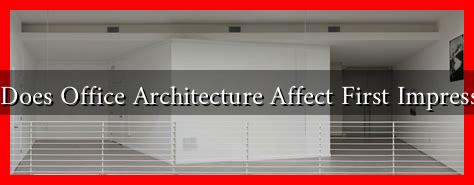-
Table of Contents
How Does Office Architecture Affect First Impressions?
First impressions are crucial in any business environment, and the architecture of an office plays a significant role in shaping these perceptions. From the layout and design to the materials used, the physical space can influence how clients, employees, and visitors perceive a company. This article explores the various ways office architecture affects first impressions, supported by examples, case studies, and relevant statistics.
The Importance of First Impressions
First impressions are formed within seconds and can be lasting. According to a study by Princeton University, it takes only a tenth of a second for someone to form an opinion about a person based on their appearance. Similarly, the architecture of an office can create immediate judgments about a company’s professionalism, culture, and values.
Key Architectural Elements Influencing First Impressions
Several architectural elements contribute to the overall impression of an office space. Here are some key factors:
- Exterior Design: The façade of a building is the first thing people see. A modern, well-maintained exterior can convey innovation and success, while a dilapidated structure may suggest neglect.
- Interior Layout: Open floor plans can promote collaboration and transparency, while closed-off spaces may create a sense of hierarchy and exclusivity.
- Lighting: Natural light can enhance mood and productivity, making a space feel welcoming. Conversely, dimly lit areas can evoke feelings of discomfort.
- Color Schemes: Colors can influence emotions and perceptions. For example, blue is often associated with trust and professionalism, while bright colors can convey creativity and energy.
- Furniture and Decor: High-quality, ergonomic furniture can suggest a company values employee well-being, while outdated or mismatched furniture may imply a lack of attention to detail.
Case Studies: Successful Office Architecture
Several companies have successfully utilized office architecture to create positive first impressions. Here are a few notable examples:
- Google: Known for its innovative office designs, Google’s headquarters in Mountain View, California, features open spaces, vibrant colors, and recreational areas. This design fosters creativity and collaboration, making a strong impression on visitors.
- Airbnb: The Airbnb office in San Francisco reflects the company’s brand ethos with its home-like design. The use of natural materials and cozy spaces creates a welcoming atmosphere that aligns with their mission of belonging.
- WeWork: As a co-working space provider, WeWork emphasizes modern design and community. Their offices are designed to be flexible and inviting, which appeals to startups and freelancers looking for a collaborative environment.
Statistics on Office Design and Employee Perception
Research indicates that office design significantly impacts employee satisfaction and productivity, which in turn affects first impressions. According to a survey by the International Facility Management Association (IFMA):
- 75% of employees believe that their work environment affects their productivity.
- 68% of employees feel that their office design reflects their company’s culture.
- Companies with well-designed offices report a 20% increase in employee satisfaction.
Conclusion: The Lasting Impact of Office Architecture
In conclusion, office architecture plays a pivotal role in shaping first impressions. From the exterior design to the interior layout, every element contributes to how clients and employees perceive a company. As businesses continue to evolve, investing in thoughtful office design can enhance brand image, improve employee satisfaction, and ultimately lead to greater success. Companies looking to make a positive first impression should consider how their office architecture reflects their values and culture.
For more insights on the impact of office design, you can explore resources from the International Facility Management Association.

